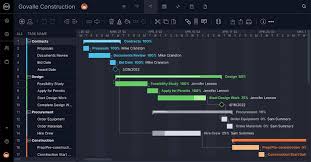In the fast-paced construction industry, staying on schedule can make or break a project. Meeting deadlines, coordinating subcontractors, and managing materials require careful planning and real-time oversight. Traditional tools like spreadsheets or paper-based schedules are no longer efficient enough. That’s where powerful tools like Bauzeitenplan Software. from Flexxter come in—offering smarter, more streamlined ways to handle project scheduling.
This article explores how construction companies—especially in Germany—can use modern scheduling tools to improve productivity, avoid costly delays, and ensure better team collaboration on every job site.
Why Construction Scheduling is Crucial
Construction projects involve hundreds of moving parts: labor, materials, equipment, permits, inspections, and unexpected delays due to weather or supply chain issues. Without a clear, flexible schedule, even the most well-planned projects can derail.
A construction schedule helps:
Break down a project into manageable tasks
Allocate time and resources to each phase
Coordinate teams and subcontractors
Track project milestones
Communicate clearly with stakeholders
Modern tools replace manual tracking with real-time updates, allowing project managers to adjust timelines as needed and avoid disruptions.
Common Scheduling Challenges in Construction
Construction teams often face scheduling problems that cause budget overruns or delayed handovers. Common issues include:
Inaccurate timelines: Poor estimates can lead to schedule compression and stress
Lack of communication: If updates aren’t shared, teams may show up unprepared
Manual tracking: Paper schedules and spreadsheets are slow and error-prone
Changes on-site: Unplanned events require instant schedule adjustments
Dependency conflicts: Tasks that depend on other jobs being finished can get delayed
Modern scheduling software is designed to solve these problems with automation, collaboration, and visibility.
What is Bauzeitenplan Software?
“Bauzeitenplan Software” translates to construction schedule software, and it’s specifically designed to support the needs of contractors, architects, and project managers. In Germany, where regulatory timelines and stakeholder expectations are strict, having accurate, updated schedules is essential.
A strong Bauzeitenplan Software will:
Create Gantt chart-based timelines
Allow drag-and-drop editing for rescheduling
Offer cloud-based access for team collaboration
Send alerts and notifications when deadlines change
Provide mobile access on-site
Flexxter, for example, offers all of these functions and more—making it a valuable tool for German construction companies who need reliability and clarity on every build.
Benefits of Using Construction Scheduling Software
Switching to digital tools offers a wide range of benefits for project leaders and companies:
1. Real-Time Project Visibility
With cloud-based solutions, everyone involved—from the office team to subcontractors on-site—can view the latest timeline. This keeps everyone aligned and avoids costly miscommunication.
2. Easier Adjustments
When something changes (and it always does), you don’t need to rewrite the entire plan. Just drag and drop tasks, adjust dependencies, and notify affected team members instantly.
3. Improved Collaboration
Construction scheduling software centralizes communication. Team members can leave notes, upload documents, and receive automatic reminders about deadlines.
4. Better Resource Management
Scheduling software helps you allocate people, machinery, and materials efficiently—reducing idle time and maximizing productivity.
5. Lower Risk of Delays
With smarter forecasting and real-time adjustments, project managers can react quickly to delays and find workarounds to stay on track.
How to Choose the Right Scheduling Tool
Not all project management software is created equal. Here are key features to look for in a good Bauzeitenplan Software:
Intuitive interface: Easy for teams to learn and adopt
Cloud-based access: Available anytime, anywhere
Multi-language support: Important for diverse crews
Mobile app: For updates and access on job sites
Data security: Especially critical for regulated industries
Integration with other tools: Like cost tracking or document management
Flexxter is an excellent example of a solution tailored to the construction industry in Germany. Its features match the unique demands of small and medium-sized construction companies who want to work smarter, not harder.
Who Benefits from Bauzeitenplan Software?
This type of tool is useful for nearly every stakeholder involved in a construction project:
➤ Project Managers
They get a complete overview of the timeline, resources, and responsibilities—and the ability to make changes instantly.
➤ Subcontractors
They receive real-time updates and notifications when changes occur, helping them stay on top of the schedule.
➤ Architects
They can collaborate more closely with builders to align design changes with scheduling constraints.
➤ Clients and Stakeholders
They have transparency into the process and can track project progress in real time.
Real-World Use Case: A Medium Construction Company in Germany
Let’s say a mid-sized construction company in Berlin is working on a commercial building. Before using software, their project managers struggled with:
Paper-based timelines
Confusing email threads
Subcontractors missing deadlines
Poor visibility on task progress
After adopting Flexxter’s Bauzeitenplan Software, they saw improvements in:
Coordination between teams
Faster schedule updates
Fewer communication issues
A smoother path to project completion
This is just one of many examples of how digital scheduling tools can transform everyday operations on construction sites.
The Future of Construction Planning
As the industry moves toward digital transformation, construction scheduling software is no longer optional—it’s essential. Technologies like AI, automation, and real-time collaboration will continue to shape how companies manage timelines and resources.
Soon, we’ll see even more innovations:
Predictive scheduling using weather and labor data
Automated alerts for potential conflicts
Integrations with drones and 3D models
AI-driven planning based on previous project outcomes
Construction companies that invest in digital planning tools now are setting themselves up for success in a rapidly evolving landscape.
Final Thoughts
Construction scheduling doesn’t have to be a logistical nightmare. With the right tools, project leaders can gain complete control over timelines, reduce stress, and deliver better results.
Solutions like flexxter.com provide the flexibility, collaboration, and real-time insights that modern construction demands. Whether you’re managing a residential build or a large commercial project, making the switch to digital scheduling is a smart investment in your team’s productivity and your company’s reputation.


